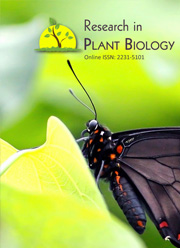Characterization of non polar-polar solvent extracts from some tea plantation shade tree leaves with special reference to antioxidant and antibacterial activities
DOI:
https://doi.org/10.25081/ripb.2020.v10.6235Keywords:
Tea plantation, shade tree, solvents, antioxidant, antibacterialAbstract
Beneficial properties of shade trees of tea plantations other than their medicinal properties have been extensively studied. This research was initiated to explore the properties of some shade trees with special emphasis on their antioxidant and antibacterial properties. Leaves from shade tree like Dalbergia sissoo (DS), Cassia siamea (CS), Derris robusta (DR), Leucaena leucocephala (LL), Acacia lenticularis (AL) and Melia azedarach (MA) were used for the study. Characterization of shade tree leaves by determination of moisture, crude fibre and ash content and tests of non polar – polar solvent extracts for steroid, tannins, cardiac glycosides and coumarin, free radical scavenging, ferric reducing power, NO scavenging activities, quantification of Flavonoids and antibacterial activity were conducted. The average moisture, crude fibre and ash percentage of shade tree plants were found to be 62.95, 11.28 and 1.86 respectively. Methanol, ethanol, acetone and ethyl acetate respectively proved to be the most potent solvent for various phytochemical extractions as it gave positive results for tests like tannin, steroid, cardiac glycosides and coumarin. AL (91.46%), DR (92.69%), LL (94.32%) and MA (93.34%) leaf extracts showed a high level of DPPH scavenging activity in their water extracts. In DS (88.11%) and CS (83.23%) maximum DPPH scavenging activity was observed in Diethyl ether and Methanol extracts respectively. Acetone extracts were more active than the water extracts in exhibiting ferric reducing power and NO scavenging activity. Summation of the quantity revealed that DS showed maximum presence of flavonoids and acetone as most potential for isolation of flavonoids. The decreasing order of summative antibacterial activity was recorded in DS, followed by CS, DR, AL, MA and LL. Chloroform showed the highest summative inhibition zone followed by ethanol, ethyl acetate, diethyl ether, acetone, water, hexane, benzene and methanol. The antioxidant and antibacterial potential of shade trees were established.



 .
. 